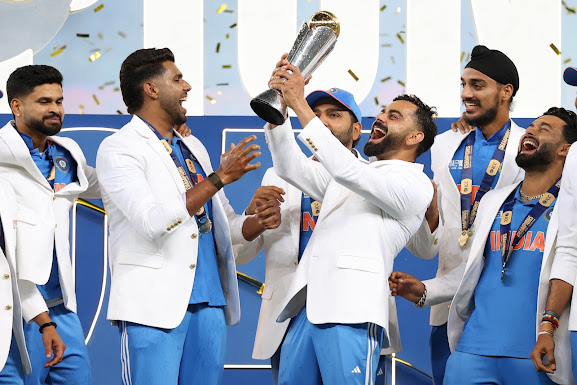An Ode to Virat Kohli
O Captain! My Captain!
Rise up—for you the flag is flung—for you the bugle trills,
For you bouquets and ribbon’d wreaths—for you the shores a-crowding,
For you they call, the swaying mass, their eager faces turning;
138 Matches, 70 wins, 2x Semi-Finalists, 3x Runners-Up, 1x Champions, 13000+ runs, 31 hundreds, 69 fifties, and a legacy of unimaginable and unforgettable moments across Tests and T20s.
There are cricketers, then there are those remarkable, shining souls who surpass the game, who don't just play it but redefine its very rhythm, re-tape its myth, and rename its meaning. Virat Kohli is one of that privileged band of immortals, not only a run-scoring maestro or record-setter, but the voracious heartbeat at the very center of Indian cricket for over a decade. His legacy is not of numbers and scorecards, but of will that dared, of unconquerable passion, and a mind that dreamed when others cowered.
The story begins not under stadium lights, but in the quiet agony of a teenager’s unimaginable grief. When Virat was 18, he lost his father, his mentor, his rock, his idol. But even as sorrow mushroomed, threatening to paralyze him, Kohli performed as champions do: he laced his boots and walked out the next day in a Ranji Trophy match. Under the weight of loss hanging over him, he stood and scored for Delhi. It was no ordinary knock; it was a declaration. That the spark in him, though tiny, was burning brighter than anything the world could throw at him.
However, his most significant contribution to Indian cricket would never come in the guise of a single match or tournament: it would be as a leader. When MS Dhoni handed over the Test leadership to him on the tour of Australia in 2014–15, Indian cricket was at a crossroads. The team was struggling, their will bruised, their pride wounded. Kohli, inexperienced and raw as a captain, didn't take the easy way out or seek refuge. He opted for glory, even at the risk of loss. It was during the Sydney Test that he urged his team to attempt the impossible rather than accept a draw. That mindset of aggressive, unrepentant desire would define the Kohli era.
And what an era.
He crafted a Test team that was unbeatable at home and an overseas force to be reckoned with. Kohli-era India did something that once seemed a pipedream: they took a series away from Australia. They drew in England. They punched above their weight repeatedly, not just motivated by individual brilliance, but by belief, aggression, and camaraderie. And at the back of it all was Kohli, chest out, eyes blazing, shouting “let’s give them hell for 60 overs” as India swept to a traditional win at Lord’s in 2021.
He didn’t just want to win. He wished to govern, to inspire, to ensure that Indian cricket was a power source that provoked respect wherever it went. Off the field, his imprints were everywhere. He popularized fitness like nobody else. He re-fashioned a side once renowned for spin into a pace battery so lethal it unsettled opposition in their own lair. Not just Bumrah or Shami or Siraj; the atmosphere Kohli created. One of accountability. Of relentless self-improvement. Of chasing greatness as an obligation, not a fantasy.
Even as he built the citadel in whites, his magic in colored kits never ceased. In the 2016 T20 World Cup, he again reached godlike stature. In the quarterfinal against Australia, he put the country’s hopes on his shoulders, presiding over a chase of sheer beauty. The semifinal against the West Indies was a losing cause, yes, but Kohli’s 89* was a masterclass in artistry and courage, a song of resistance in the face of doom.
But perhaps the greatest chapter of Kohli’s legend came in the twilight of his T20 career, at the cauldron of the MCG in 2022. Diwali night. 90,000 hearts pounding. India reduced to 31 for 4 against Pakistan. Silence of a billion broken dreams. And then came Kohli. With the dignity of a saint and the anger of a warrior, he stitched hope out of destruction, faith out of wreckage. The shot that set it all in motion, walking down the track and pulling Haris Rauf high over his head for six, was not just a shot. It was scripture. A divine act of rebellion. He finished on 82*, but what he really did that night was remind India who they were.
Nevertheless, despite all the greatness, one thing had persistently remained out of reach. A major trophy for the team. Post the Champions Trophy of 2013, India kept reaching finals and semifinals, only to falter at the last moment.








Comments
Post a Comment